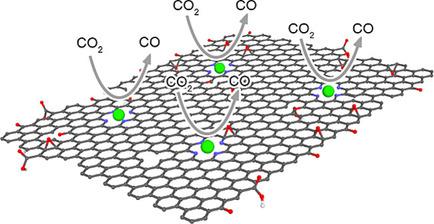当前位置:
X-MOL 学术
›
Chem. Eur. J.
›
论文详情
Our official English website, www.x-mol.net, welcomes your feedback! (Note: you will need to create a separate account there.)
Tris(2‐benzimidazolylmethyl)amine‐Directed Synthesis of Single‐Atom Nickel Catalysts for Electrochemical CO Production from CO2
Chemistry - A European Journal ( IF 3.9 ) Pub Date : 2018-10-08 , DOI: 10.1002/chem.201803615 Hui‐Yun Jeong 1 , Mani Balamurugan 1 , Venkata Surya Kumar Choutipalli 2, 3 , Janghyun Jo 1 , Hionsuck Baik 4 , Venkatesan Subramanian 2, 3 , Miyoung Kim 1 , Uk Sim 5 , Ki Tae Nam 1, 6
Chemistry - A European Journal ( IF 3.9 ) Pub Date : 2018-10-08 , DOI: 10.1002/chem.201803615 Hui‐Yun Jeong 1 , Mani Balamurugan 1 , Venkata Surya Kumar Choutipalli 2, 3 , Janghyun Jo 1 , Hionsuck Baik 4 , Venkatesan Subramanian 2, 3 , Miyoung Kim 1 , Uk Sim 5 , Ki Tae Nam 1, 6
Affiliation

|
The electrochemical reduction of carbon dioxide (CO2) to value‐added products is a promising approach to reducing excess CO2 in the atmosphere. However, the development of electrocatalysts for highly selective and efficient electrochemical CO2 reduction has been challenging because protons are usually easier to reduce than CO2 in an aqueous electrolyte. Recently, single‐atom catalysts (SACs) have been suggested as candidate CO2 reduction catalysts due to their unique catalytic properties. To prepare single‐atom metal active sites, the stabilization of metal atoms over conductive supports such as graphene sheets to prevent metal aggregation is crucial. To address this issue, a facile method was developed to prepare single‐atom nickel active sites on reduced graphene oxide (RGO) sheets for the selective production of carbon monoxide (CO) from CO2. The tris(2‐benzimidazolylmethyl)amine (NTB) ligand was introduced as a linker that can homogeneously disperse nickel atoms on the graphene oxide (GO) sheets. Because the NTB ligands form strong interactions with the GO sheets by π–π interactions and with nickel ions by ligation, they can effectively stabilize nickel ions on GO sheets by forming Ni(NTB)‐GO complexes. High‐temperature annealing of Ni(NTB)‐GO under inert atmosphere produces nickel‐ and nitrogen‐doped reduced graphene oxide sheets (Ni‐N‐RGO) with single‐atom Ni−N4 active sites. Ni‐N‐RGO shows high CO2 reduction selectivity in the reduction of CO2 to CO with 97 % faradaic efficiency at −0.8 V vs. RHE (reversible hydrogen electrode).
中文翻译:

三(2-苯并咪唑基甲基)胺定向合成单原子镍催化剂,用于从二氧化碳中电化学生产二氧化碳
用电化学方法将二氧化碳(CO 2)还原为增值产品是减少大气中过量CO 2的一种有前途的方法。然而,由于质子通常比含水电解质中的CO 2更容易还原,因此用于高选择性和高效电化学CO 2还原的电催化剂的开发一直具有挑战性。最近,有人建议将单原子催化剂(SAC)用作候选CO 2。还原催化剂,由于其独特的催化性能。要制备单原子金属活性位,至关重要的是在导电支撑物(例如石墨烯片)上稳定金属原子,以防止金属聚集。为了解决这个问题,开发了一种简便的方法来在还原的氧化石墨烯(RGO)板上制备单原子镍活性位,以从CO 2中选择性生产一氧化碳(CO)。。引入三(2-苯并咪唑基甲基)胺(NTB)配体作为连接剂,可将镍原子均匀分散在氧化石墨烯(GO)板上。因为NTB配体通过π-π相互作用与GO片形成强相互作用,而通过连接与镍离子形成强相互作用,它们可以通过形成Ni(NTB)-GO络合物有效地稳定GO片上的镍离子。在惰性气氛下对Ni(NTB)-GO进行高温退火会生成具有单原子Ni-N 4活性位的镍和氮掺杂的氧化石墨烯薄板(Ni-N-RGO)。Ni-N-RGO在相对于RHE(可逆氢电极)的−0.8 V时具有97%的法拉第效率,在将CO 2还原为CO方面显示出高的CO 2还原选择性。
更新日期:2018-10-08
中文翻译:

三(2-苯并咪唑基甲基)胺定向合成单原子镍催化剂,用于从二氧化碳中电化学生产二氧化碳
用电化学方法将二氧化碳(CO 2)还原为增值产品是减少大气中过量CO 2的一种有前途的方法。然而,由于质子通常比含水电解质中的CO 2更容易还原,因此用于高选择性和高效电化学CO 2还原的电催化剂的开发一直具有挑战性。最近,有人建议将单原子催化剂(SAC)用作候选CO 2。还原催化剂,由于其独特的催化性能。要制备单原子金属活性位,至关重要的是在导电支撑物(例如石墨烯片)上稳定金属原子,以防止金属聚集。为了解决这个问题,开发了一种简便的方法来在还原的氧化石墨烯(RGO)板上制备单原子镍活性位,以从CO 2中选择性生产一氧化碳(CO)。。引入三(2-苯并咪唑基甲基)胺(NTB)配体作为连接剂,可将镍原子均匀分散在氧化石墨烯(GO)板上。因为NTB配体通过π-π相互作用与GO片形成强相互作用,而通过连接与镍离子形成强相互作用,它们可以通过形成Ni(NTB)-GO络合物有效地稳定GO片上的镍离子。在惰性气氛下对Ni(NTB)-GO进行高温退火会生成具有单原子Ni-N 4活性位的镍和氮掺杂的氧化石墨烯薄板(Ni-N-RGO)。Ni-N-RGO在相对于RHE(可逆氢电极)的−0.8 V时具有97%的法拉第效率,在将CO 2还原为CO方面显示出高的CO 2还原选择性。












































 京公网安备 11010802027423号
京公网安备 11010802027423号